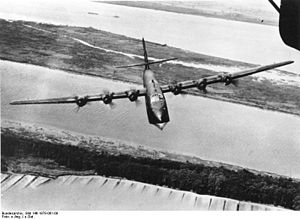Who Operated the Largest Aircraft During World War Two? – August 17, 2018

Orville Wright, Samuel Langley, and The Battle With The Smithsonian – August 10, 2018
August 10, 2018
Betty Skelton…..Aviation’s Sweetheart – August 24, 2018
August 24, 2018Robert Novells’ Third Dimension Blog
August 17, 2018
Good Morning and Happy Friday,
This week I want to talk about a seaplane, one of my favorite subjects, that was the largest aircraft operated during World War Two. The airplane was built by Blohm & Voss BV, a German Company, and was given the name Wiking (German for “Viking). The official designation was BV-222 and although it was built for Lufthansa to be used commercially the German military quickly saw the potential and took over the project.
Enjoy…..
Blohm & Voss
BV 222 Wiking (Viking)
Prior to World War II, the German airline Luftansa had carried out many transatlantic mail flights but their main interest was passenger transport. They initiated a program in 1936 for which Hamburger Flugzeugbau offered the Ha 222, a very large flying boat designed by Dr. Richard Vogt. By the time an order for three was received and work began, the company had changed its name to that of its parent company, Blohm & Voss, and the design was redesignated the BV 222.
The design yielded a first prototype designated V1 in 1938. V2 and V3 would follow within weeks. The BV 222 aircrafts ranged from V1 to V8. V1 had a capacity of 92 passengers and a maximum speed of 239 mph. It made its test flights on 7th September 1940, and its flight characteristics were satisfactory. However, improvements were required.
In December 1940, the V1 passed into Luftwaffe service, receiving all the formatting required for aircraft serving with the German aerial warfare branch.
Originally, it was powered by a Brammo 323 Fafnir engine, but later versions would be powered by six 1000 hp inline diesel engines which permitted refueling at sea using resupply U-boats.
By August 1941, the V1 had completed seven flights between Hamburg and Kirkenes, transporting about 65,000 kg of supplies and 221 wounded men across a total distance of 30,000 km. It also flew to Athens, carrying supplies for the Afrika Korps. During this time, it was unarmed and was escorted by two Messerschmitt Bf 110 heavy fighters.
After these flights, the V1 was equipped with a defensive armament comprising a 7.92 mm MG 81 machine gun in the hull, two 13 mm MG 131 machine guns which were mounted on its turret, and four 7.92 mm MG 81 machine guns which were fixed at the rear. It would sink in February 1943 following a collision with a submerged wreck while landing at Piraeus harbor.
Following the German invasion of the Soviet Union in June 1941, plans were made to connect Germany and Japan by air using Luftwaffe aircraft modified for very long range flights since commercial flights to the Far East by Luftansa were no longer possible, and it had become very dangerous for ships or U-boats to make the trip by sea. Field Marshal Erhard Milch authorized a study in to the feasibility of such direct flights and various routes were considered, including departing from German-occupied Russia and Bulgaria, and a sea route using a BV 222 flying from Kirkenes in north Norway to Tokyo via Sakhalin Island, a distance of 6,400 km (4,000 mi).
The BV 222 was one of three aircraft considered seriously for the program, along with the Focke-Wulf Fw 200 and the Heinkel He 177. The He 177 was ruled out due to it being considered unreliable and in 1943 the Junkers Ju 290 was selected for the flights.
Three BV 222s were captured and subsequently operated by Allied forces: C-011, C-012, and C-013. C-012, captured at Sørreisa in Norway after the war along with V2, was flown by Captain Eric “Winkle” Brown from Norway to the RAF station at Calshot in 1946, with RAF serial number “VP501”. After testing at Marine Aircraft Experimental Establishment at Felixstowe it was assigned to No. 201 Squadron RAF, who operated it up to 1947, when it was scrapped.
C-011 and C-013 were captured by US forces at the end of World War II. On August 15 and again on August 20, 1945 LT Cmdr Richard Schreder of the US Navy performed test flights along with the German crew of one of the BV 222 aircraft that had been acquired by the US. In two flights resulting in a total flight time of 38 minutes they experienced 4 engine fires. While many spare engines were available they were of substandard quality due to the lack of quality alloys near the end of the war, and caught fire easily. Since the aircraft was not airworthy with these engines, the aircraft was taken out to open water and sunk by a navy destroyer.
Other reports indicate the US captured aircraft were flown or shipped to the US. Convair acquired one for evaluation at the Naval Air Station Patuxent River, the intensive studies leading to the hull design of their Model 117 which in turn led to the R3Y Tradewind. Their subsequent fate is unknown.
Source Document One —— Source Document Two
Have a good weekend, enjoy the video below, and take care/fly safe/be safe.
Robert Novell
August 17, 2018


